There's a fairly famous satire of virtual meetings: "The Conference Call," by Dave Grady. If you haven't seen it yet, or if it's been a while since you've seen it, now's your chance:
Probably Skip to the Details:
How To Orderyour meetings aren't quite that bad — not most of them, anyway. OK, maybe for some
of you, they are. But even if your virtual meetings are barely tolerable, they can still be
maddeningly frustrating.
Would you like to just get your work done?
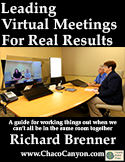 Leading Virtual Meetings for Real Results shows you hundreds of ways to make your
virtual meetings better. No, really — Hundreds. And many of the things you can do to make your
virtual meetings better cost nothing. Most of them don't even require approvals
from anyone else. You can just do them.
Leading Virtual Meetings for Real Results shows you hundreds of ways to make your
virtual meetings better. No, really — Hundreds. And many of the things you can do to make your
virtual meetings better cost nothing. Most of them don't even require approvals
from anyone else. You can just do them.
Leading Virtual Meetings shows you how to explore the "risk space" of virtual meetings. By applying this method to a common class of virtual meetings — the virtual team meeting — readers see how to use this method and adapt it to their own particular needs. And it's organized by risk: Infrastructure Risk, User Equipment Risk, Human Behavior Risk, Presentation Risk, and so on. See the Table of Contents for the general organization.
Within each chapter you'll find a collection of short tips, ranging from 100 to 500 words. Each tip is focused on one aspect of managing a risk: understanding what generates the risk, explaining what the risk looks like when it materializes, mitigating the risk, and dealing with unexpected manifestations of the risk once they've occurred.
Unlike many business books, this one is designed as an ebook for the hyper-reader. That is, even though it reads well cover-to-cover, you don't need to read it that way. You can search for topics related to the challenges you face, and when a term or phrase is used that you want to see defined or explored further, you can click or tap that term and see the definition or explore that term further.
This ebook is also available as an iBook at Apple's iTunes Store. Since all my ebooks are available in Acrobat (PDF) format, you've always been able to read them on ebook readers, such as iPad, iPhone, Nook, or Kindle. But this iTunes version makes use of the special capabilities of modern ebook readers. Check it out!
Some sample tips
Here are some samples:
- Know how to manage runaway dialogs
- A runaway dialog occurs when an exchange between two attendees devolves into a detailed discussion between them, with all other attendees looking on or listening in. In face-to-face meetings, this phenomenon is costly enough, but the cost is only time and perhaps some feelings of being excluded. In virtual meetings, the cost is much higher, because in virtual meetings the onlookers (on-listeners?) are free to occupy themselves in other ways, using any of the multitude of distractions available to them. Bringing the meeting back together after a derailment like a runaway dialog can be costly in terms of time and lost contributions. And, of course, unless you can see everyone, you can't really tell that everyone is back from whatever they decided to do instead of attend to the runaway dialog.
- The problem has a more advanced form that appears in serial virtual meetings in which the same pair of participants regularly engage in runaway dialogs. Under those conditions, when the first member of the pair speaks, and the second member responds, many of the other attendees recognize that simple exchange as Step One of a runaway dialog, even if it isn't. They then disengage from the meeting. In this way, disengagement can occur even if a runaway dialog doesn't occur.
- One solution: have a three-exchange limit for dialogs.
- Choose site names carefully
- The names of the sites of a virtual meeting can inadvertently convey status messages. When they do, the conveyed status is conferred on the participants located at those sites, independent of their actual contributions to the business of the meeting. The status they acquire can lead to evaluations of their contributions that aren't based on the merits of those contributions, and this can distort the outcomes of the meeting.
- For example, a site called "Field Office" is typically less important organizationally than a site called "Corporate Headquarters." When someone from the Field Office site contributes to the discussion an idea that contradicts a position favored by someone from Corporate Headquarters, some participants might be biased against it, outside their awareness. Others are biased and they know it. Still others have no real position of their own, but they believe that going against Corporate is a bad idea, so they adopt a biased stance.
- Other sources of difficulty are the cultural connotations of site names. In some cultures, for example, certain numbers have significant negative connotations. For instance, in some Western cultures, many believe that 666 is associated with evil. Referring to a site as 666 because it's located at 666 Enterprise Boulevard might therefore be problematic. Most cultures associate names, concepts, words, and at least some numbers with negative concepts or bad luck. Verify that the site names you're choosing are free of undesirable baggage.
- Know how to deal with virtual controversies
- Because controversies enhance the urge to contribute to the discussion, the speaker queue can become lengthy and unmanageable. By the time someone's turn to speak rolls around, what they had to say might have been said already, or contradicted by facts offered by another, or even refuted preemptively. People can feel frustrated even if none of this happens, as they sit and wait their turn to speak. Emotions run higher, faster, than they do in face-to-face meetings. The online disinhibition effect (sometimes known as "keyboard courage") complicates matters even further.
- The online disinhibition effect was first identified by John Suler [Suler 2004]. The essential idea is that when we interact face-to-face, inhibitions prevent us from behaving inappropriately. In the virtual environment, these inhibitions are much weaker.
- Controversies are helpful. Their existence indicates engagement and interest. Although we can usually resolve controversies in face-to-face meetings, virtual meetings present difficulties. Do as much as you can to focus the conversation in advance of the meeting using small-group interactions, such as one-on-one telephone conversations.
- To deal with the remaining issues in a virtual meeting,
recognize that the higher the headcount, and the more complex the set of issues, the
more likely are explosions. If you expect an elevated probability of controversy, take
these steps to simplify the discussion:
- Break up the problem
- Factor it into smaller pieces, and explore the pieces one by one. Recognize that resolving the problem piecewise might not be possible. If a piece cannot be resolved independently, it can at least serve to generate a set of questions, which, if answered, could lead to resolution.
- Create caucuses
- Factor the set of attendees into groups of like mind. Assign an issue to each caucus. It's OK to assign the same issue to two or more caucuses. Have each caucus meet privately (possibly in a virtual room), and generate a set of deliverables that include either a proposed resolution and justification for it, or a list of open questions. Have each caucus designate a speaker to represent it.
- Reconvene
- When the entire group reconvenes, the discussion is limited to caucus speakers for a period of time. They engage in debate, and work together to revise the list of problems. Next, open the discussion to the full group again, to adopt the revised problem list, or to amend it and adopt it. Review caucus assignments, changing them as desired by the attendees, and repeat the process.
- Convergence is the goal. If convergence remains elusive, try assigning positions to caucuses that directly conflict with their preferences, and ask them to defend those positions. Usually this leads to new insights and breaks deadlocks. Iterate until convergence is achieved.
Screenshots
Click one of the miniature screenshot images below to expose a larger image; click that larger image to dismiss it.
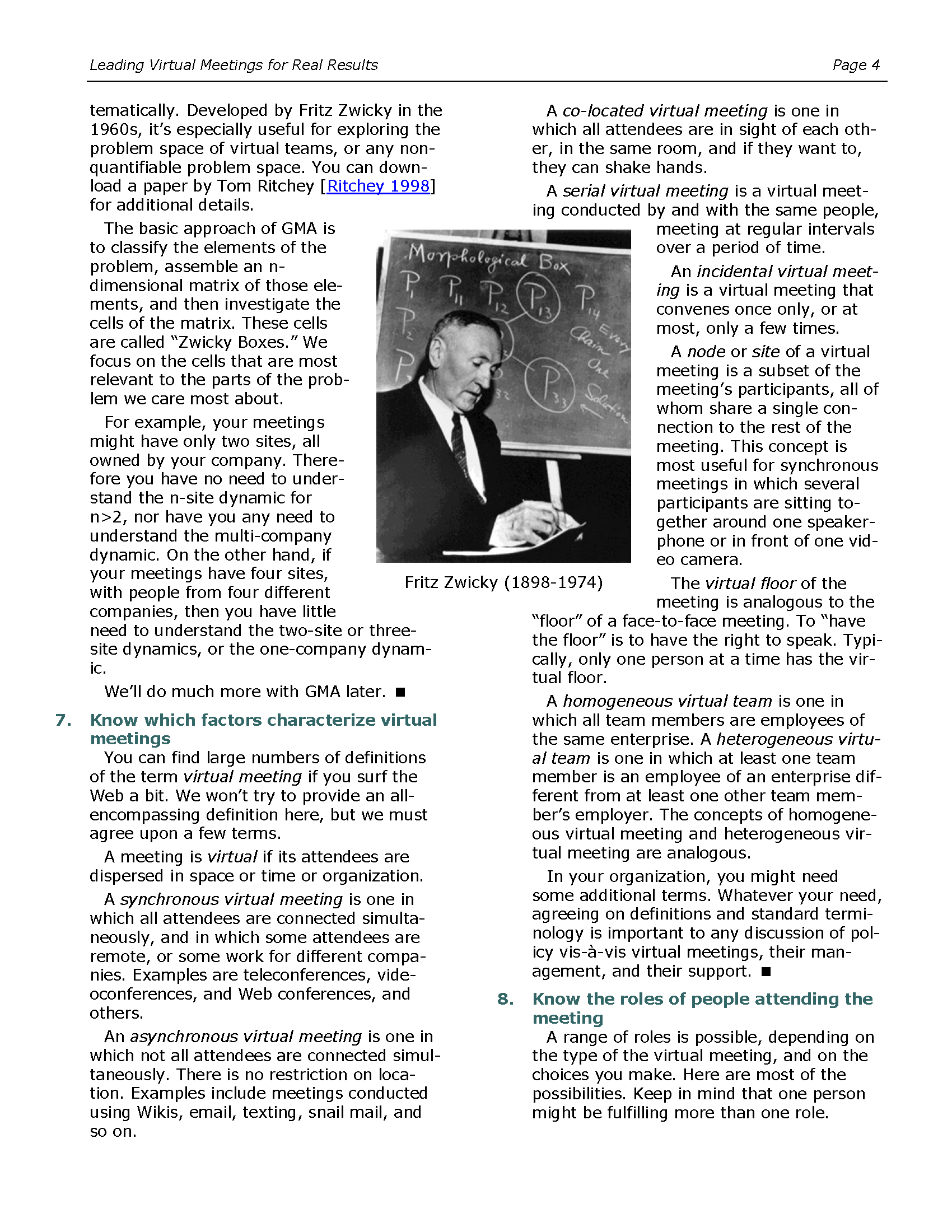
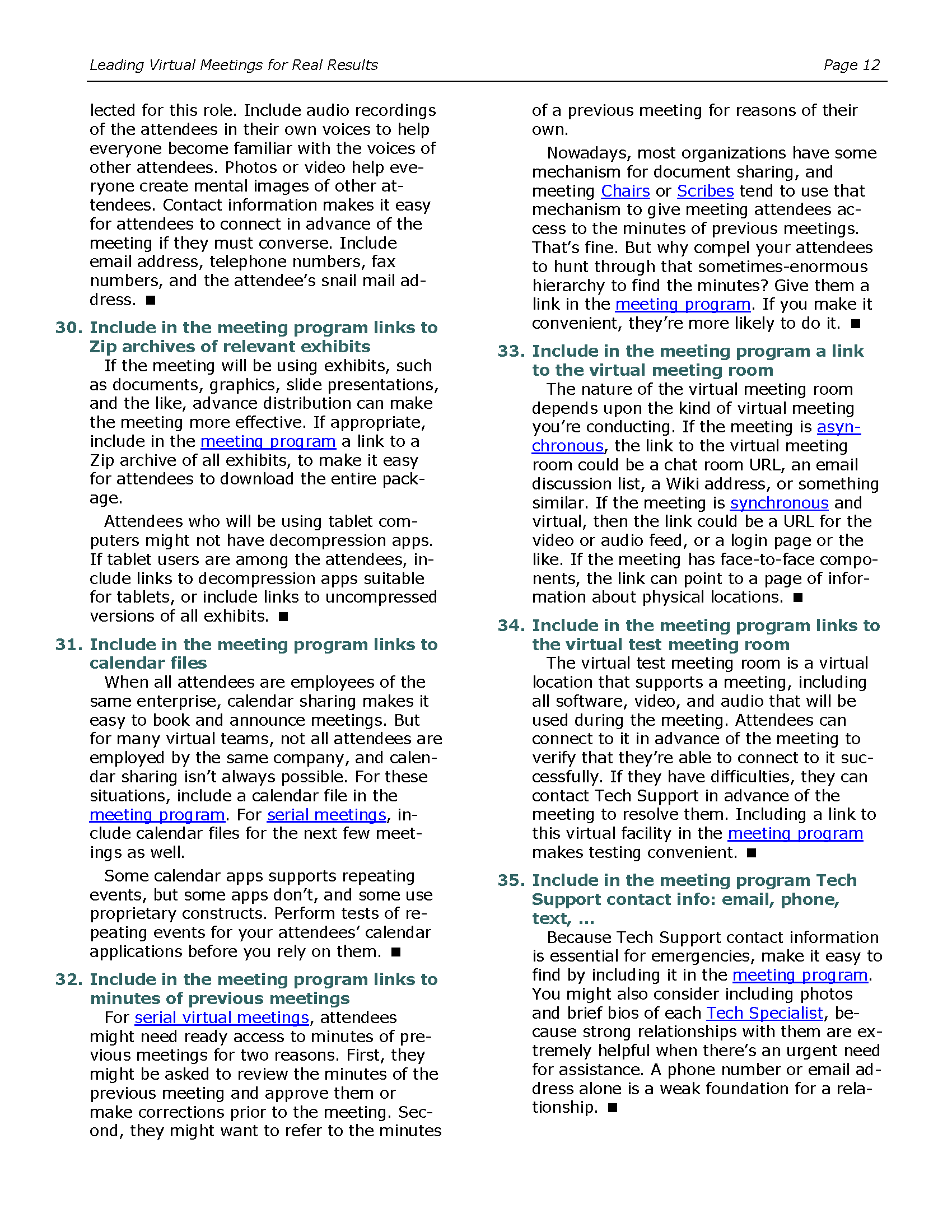

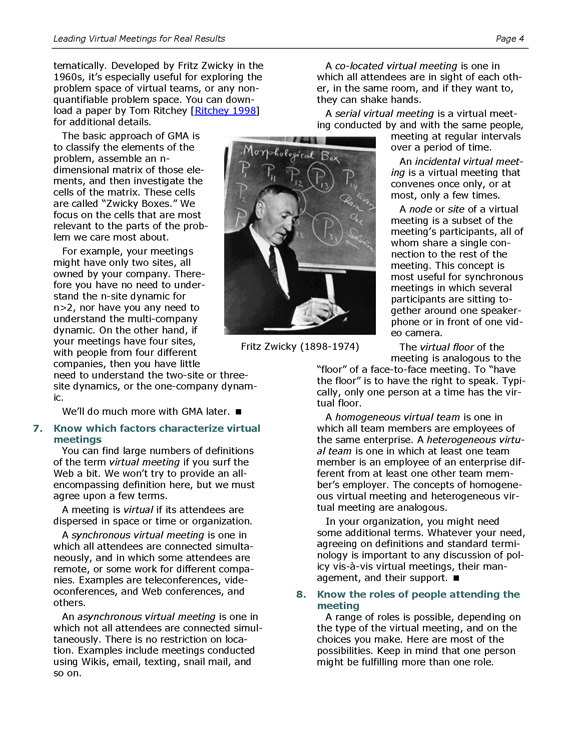
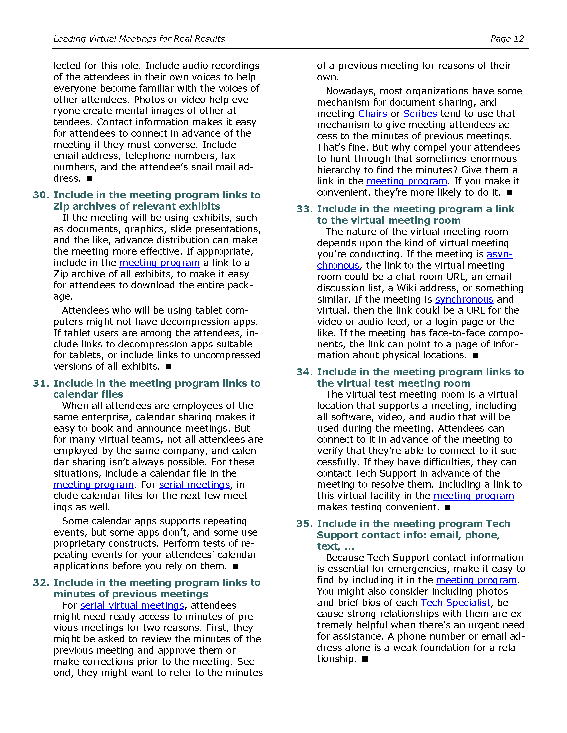
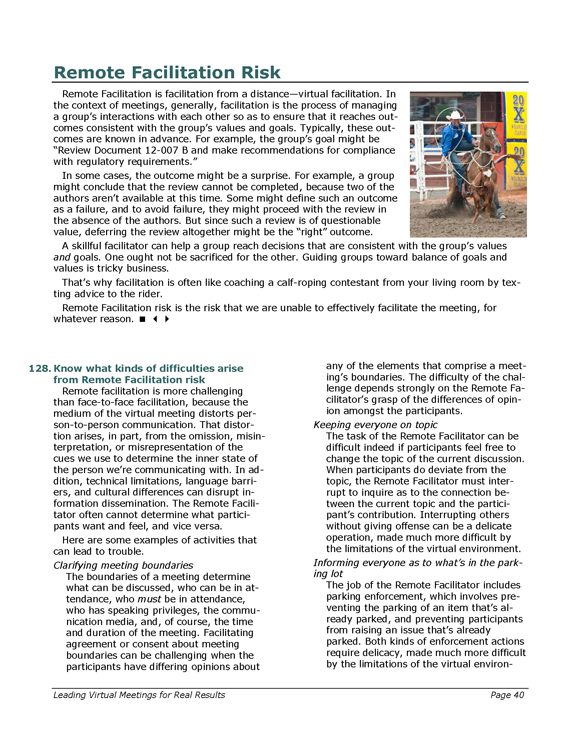
Details
This item is also available in a 10-pack (USD 115.00 per pack, or USD 11.50 per copy):
Or as a 50-pack (USD 530.00 per pack, or USD 10.60 per copy):
Or as a 100-pack (USD 860.00 per pack, or USD 8.60 per copy):
Or as a 500-pack (USD 3,550.00 per pack, or USD 7.10 per copy):
This book has an ISBN of 978-1-938932-11-3.
Table of contents
Click the folder icons to reveal (or hide) individual chapter content summaries, or:
- 1Understand the fundamental problem
- 2Adopt a strategy for dealing with the fundamental problem
- 3Understand how our past experience causes trouble
- 4Know how to observe and track optimistic expectations
- 5Make virtual meetings more predictable
- 6Understand General Morphological Analysis
- 7Know which factors characterize virtual meetings
- 8Know the roles of people attending the meeting
- 9Define a framework for applying GMA to managing virtual teams
- 10Decide which contexts are relevant for your organization
- 11Select a set of "spices" to define the flavor of your virtual meetings
- 12Understand the importance of knowing the mode of a meeting
- 13Understand the characteristics of the Arriving Mode
- 14Understand the characteristics of the Break Mode
- 15Understand the characteristics of the Announcing Mode
- 16Understand the characteristics of the Presenting Mode
- 17Understand the characteristics of the Questioning Mode
- 18Understand the characteristics of the Discussing Mode
- 19Understand the characteristics of the Deciding Mode
- 20Define the consensus-based decision processes
- 21Define the voting-related decision processes
- 22Define the authority-based decision processes
- 23Understand the characteristics of the Polling Mode
- 24Understand the characteristics of the Process Checking Mode
- 25Understand the characteristics of the Recess Mode
- 26Understand the characteristics of the Adjourning Mode
- 27Create a program, not just an agenda
- 28Notify attendees of changes in the meeting program
- 29Include in the meeting program links to attendee bios with photos, audio, video, and contact information
- 30Include in the meeting program links to Zip archives of relevant exhibits
- 31Include in the meeting program links to calendar files
- 32Include in the meeting program links to minutes of previous meetings
- 33Include in the meeting program a link to the virtual meeting room
- 34Include in the meeting program links to the virtual test meeting room
- 35Include in the meeting program Tech Support contact info: email, phone, text, …
- 36Include in the meeting program links to prep work
- 37Include in the meeting program links to electronic discussion media: chats, email lists, wikis
- 38Include in the meeting program the summary of behavioral norms
- 39Include in the meeting program links to definitions of modes
- 40Include in the meeting program links to the agenda and not-agenda
- 41Know what a performance issue is
- 42Understand why performance issues are so problematic for virtual meetings
- 43Know how to deal with performance issues
- 44Understand the nature of digressions
- 45Know what kinds of difficulties arise from Infrastructure risk
- 46Understand how communication software can create Infrastructure risk
- 47Understand how document software applications can create Infrastructure risk
- 48Understand how connection quality can create Infrastructure risk
- 49Know when Infrastructure risk is most likely to materialize
- 50Mitigating Infrastructure risk: Human Factors focus
- 51Mitigating Infrastructure risk: Technology focus
- 52Mitigating Infrastructure risk: Testing focus
- 53Mitigating Infrastructure risk: Policy and Process foci
- 54Mitigating Infrastructure risk: Contracts focus
- 55Know what kinds of difficulties arise from User Equipment risk
- 56Know when User Equipment risk is most likely to materialize
- 57Mitigating User Equipment risk: Human Factors focus
- 58Favor symmetric meetings
- 59Know how to manage asymmetric meetings
- 60Deal with the technically challenged
- 61Mitigating User Equipment risk: Technology focus
- 62Avoid exploiting sophisticated technologies
- 63Avoid dependence on a particular product or release
- 64Beware required equipment policies
- 65Anticipate software localization issues
- 66Anticipate problems with passwords
- 67Use a fresh password every time
- 68Use trailing-edge technology when possible
- 69Use virtual flip charts for the agenda, parking lot, …
- 70Become familiar with low-tech last resorts
- 71Pay special attention to BYOD-permissive environments
- 72Mitigating User Equipment risk: Testing focus
- 73Mitigating User Equipment risk: Policy and Process foci
- 74Mitigating User Equipment risk: Contracts focus
- 75Beware required equipment policies
- 76Know what kinds of difficulties arise from Schedule risk
- 77Know when Schedule risk is most likely to materialize
- 78Regard Schedule difficulties as data
- 79Mitigating Schedule risk: Contracts focus
- 80Eliminate pro forma project managers
- 81Collapse layers of subs
- 82Require participation in retrospectives
- 83Specifically mention mid-course retrospectives
- 84Monitor lessons learned in other efforts
- 85Schedule difficulties might be only temporary
- 86Have a Scheduling risk mitigation plan
- 87Mitigating Schedule risk: Policy and Process foci
- 88Use Team Standard Time
- 89Rotate the inconvenience
- 90Be aware of standard time transitions
- 91Keep current on holidays
- 92Mitigating Schedule risk: Technology focus
- 93Mitigating Schedule risk: Testing focus
- 94Know what kinds of difficulties arise from Behavior risk
- 95Know when Behavior risk is most likely to materialize
- 96Mitigating Behavior risk: Contracts focus
- 97Mitigating Behavior risk: Human Factors focus
- 98Establish behavioral norms
- 99In serial meetings, allow for roster evolution
- 100As a meeting lead, decide in advance which behavioral norms you need
- 101Understand the risks of virtual retrospectives
- 102Train team members in participation skills for virtual retrospectives
- 103For virtual retrospectives, weave preparation into execution
- 104Choose the virtual retrospective facilitator carefully
- 105In virtual retrospectives, emphasize successes
- 106Know what to do when a bully attends the meeting
- 107Mitigating Behavior risk: Policy and Process foci
- 108Understand why delegating meeting administration tasks is so important
- 109Master the art of delegation
- 110Know which roles to delegate
- 111Understand why inattentiveness plagues virtual meetings
- 112Know the indicators of inattentiveness
- 113Know how to manage participants' attentiveness
- 114Delegate responsibility to enhance overall attentiveness
- 115Know the hidden techniques for enhancing attentiveness
- 116Know how to tell who's speaking right now
- 117Deal with technology-driven Behavior risk
- 118Tailor slides to manage participant attention
- 119Learn how to flash mute
- 120Test everything
- 121Gather experience data about behavior
- 122Tips for multi-lingual and multi-cultural contexts
- 123Designate a meeting language
- 124Know how to deal with documents in the multi-lingual context
- 125Verify mission-critical document translations
- 126Know how to name things in the multi-cultural context
- 127Know how to choose interpreters and translators
- 128Vet materials for cultural sensitivities
- 129Know what kinds of difficulties arise from Remote Facilitation risk
- 130Know when Remote Facilitation risk is most likely to materialize
- 131Understand why Remote Facilitation presents difficulties when Novelty is high
- 132Understand why Remote Facilitation presents difficulties when Emotion is high
- 133Understand why Remote Facilitation presents difficulties when Stakes are high
- 134Mitigating Remote Facilitation risk: Human Factors focus
- 135Create and maintain a shared understanding of Facilitation
- 136Conduct high Stakes meetings face-to-face
- 137Know how to recognize speakers in discussion mode
- 138If you maintain a speaker queue, make it visible
- 139Know how to deal with disorder
- 140Use policy to mitigate Remote Facilitation risk
- 141Design the facilitation process to mitigate Remote Facilitation risk
- 142Know how to brief the facilitator
- 143Know how to deal with virtual controversies
- 144Dealing with facilitator bias
- 145Avoid queue branching
- 146Know how to partition complex discussions
- 147Track incidents of Remote Facilitator bias
- 148Know what to do when you detect Remote Facilitator bias
- 149Know what to do when participants dislike the facilitator
- 150Know what kinds of difficulties arise from Meeting Process risk
- 151Know when Meeting Process risk is most likely to materialize
- 152Resolve inter-organizational records retention policy conflicts
- 153For serial meetings, negotiate agreements about Infrastructure issues
- 154Understand and manage "break risk"
- 155Know how to manage runaway dialogs
- 156Mitigating Meeting Process risk: Process focus
- 157Know the art of agendas
- 158Have a not-agenda
- 159Create and maintain a parking lot
- 160Know what terms other cultures use for the parking lot
- 161Devise norms for pre-meeting behavior
- 162Devise norms for post-meeting behavior
- 163(Possibly) define an onboarding process
- 164(Possibly) define an offboarding process
- 165Mitigating Meeting Process risk: Testing focus
- 166Know what kinds of difficulties arise from Presentation risk
- 167Anticipate a reduced desire to present a polished presentation
- 168Expect problems with exhibits
- 169Understand what kinds of problems can appear when people ask questions
- 170Anticipate special problems with large audiences
- 171Understand what can happen in highly dynamic group environments
- 172Know when Presentation risk is most likely to materialize
- 173Be captivating
- 174Build your presentation around one big idea
- 175Keep it short and terse
- 176Get to the point — NOW
- 177Use videos to add interest
- 178Use a news-anchor structure
- 179Unless legalities are at issue, don't read or over-practice
- 180Stand, don't sit
- 181Present in three- to five-minute bites
- 182If you're using slides, use a remote mouse
- 183Use avatars
- 184If you're on video, get coached
- 185Change your approach to slide design
- 186Recognize that contributing is a form of presentation
- 187Mitigating Presentation risk: Human Factors focus
- 188Have defined periods for Q&A
- 189Know how to ask and answer questions
- 190Have a contributor protocol for speaking
- 191Consider offering (or getting) training for virtual presentation
- 192Define criteria for "taking it off line"
- 193Understand the effects of performance management processes
- 194As a supervisor of a virtual presenter, pay attention
- 195Mitigating Presentation risk: Technology focus
- 196Consider using Presenter View
- 197Back up all presentation materials redundantly
- 198Know how to tailor exhibits for virtual meetings
- 199Distribute exhibits in advance
- 200Use podcasts
- 201Present from a private space
- 202Use a high-quality mic
- 203Know how to test your presentation
- 204What is politics?
- 205Know what kinds of difficulties arise from Politics risk
- 206Know when Politics risk is most likely to materialize
- 207Mitigating Politics risk: Contracts focus
- 208Mitigating Politics risk: Human Factors focus
- 209Workplace politics is not a game
- 210Know what to do when Power attends the meeting
- 211Know how to make durable deals
- 212Understand what factors degrade trust in the virtual environment
- 213Understand why toxic virtual conflict thrives in the virtual environment
- 214Know how to deal with toxic virtual conflict
- 215Know how to recognize and deal with "Plopping"
- 216Mitigating Politics risk: Policy focus
- 217Choose site names carefully
- 218Value the skill of technical diplomacy
- 219Value the skill of finding a third way
- 220Educate high-level decision makers about the true cost of travel
- 221Rotate geographical configurations
- 222Eliminate coercive management
- 223Minimize split assignments
- 224Limit changes in team composition
- 225Mitigating Politics risk: Process focus
- 226Make it easy for people to get to know each other
- 227Understand that silence is ambiguous
- 228Know what to do when Power attends the meeting secretly
- 229Mitigating Politics risk: Technology focus
- 230Know who is virtually present
- 231Know who has downloaded what and when
- 232Measure meeting performance
- 233Know how to measure the incidence of misunderstandings
- 234Track attendance
- 235Mitigating Politics risk: Testing focus
Follow Rick
Send an email message to a friend
rbrenIyeJIiAfnGdKlUXrner@ChacsxirZwZlENmHUNHioCanyon.comSend a message to Rick
![]() A Tip A Day feed
A Tip A Day feed
![]() Point Lookout weekly feed
Point Lookout weekly feed
 My blog, Technical Debt for Policymakers, offers
resources, insights, and conversations of interest to policymakers who are concerned with managing
technical debt within their organizations. Get the millstone of technical debt off the neck of your
organization!
My blog, Technical Debt for Policymakers, offers
resources, insights, and conversations of interest to policymakers who are concerned with managing
technical debt within their organizations. Get the millstone of technical debt off the neck of your
organization!Point Lookout by
starting your Amazon search here

